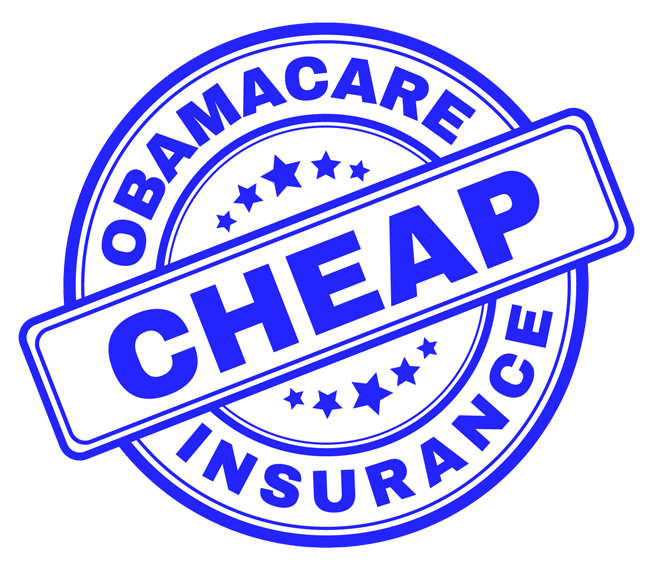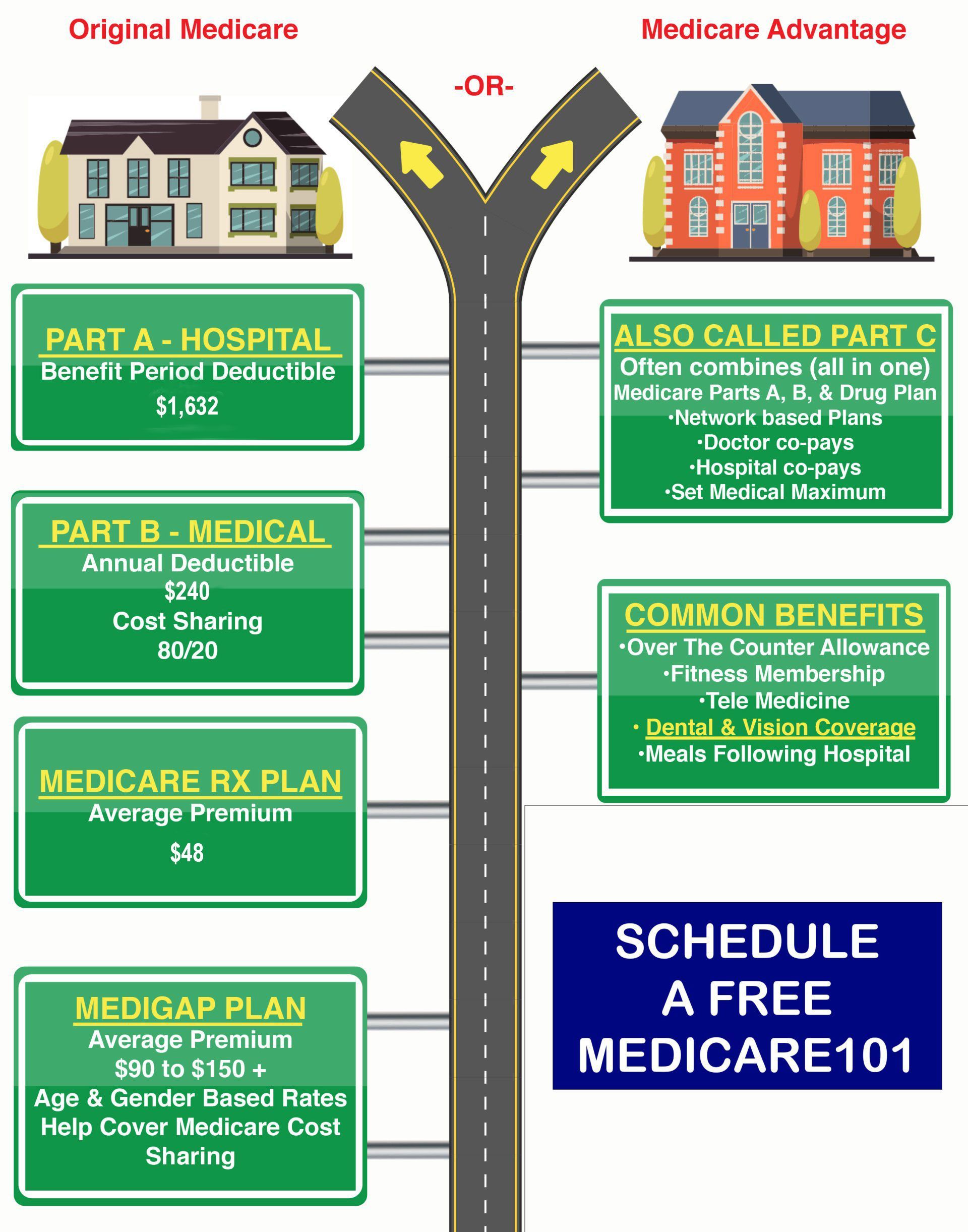Confused about Medicare?
Two Directions You Can Go
-
Trial Right #1:
If you're new to Medicare @ age 65 Medicare will let you "Test Drive" a Medicare Advantage Plan for 1 year. Change your mind and want a Medigap Plan? That's ok because you can switch directions and go back to Original Medicare and also join a supplement plan w/out having to answer health questions.
-
Trial Right #2
You start out on the left side w/ Original Medicare and Medigap Plan. Change your mind years later? That's ok because you can drop the Medigap and test drive a Medicare Advantage Plan and if you change your mind then you can change directions again and re-join your Medigap Plan.
Medicare gives you the ability to choose at least one of the following coverage types:
- Medicare Part A – Provides inpatient hospital coverage
- Medicare Part B – Provides outpatient medical coverage (Part A and B combined create Original Medicare)
- Medicare Part C – Also called Medicare Advantage; combines Part A and B coverage and may provide prescription drug coverage
- Medicare Part D – Provides prescription drug coverage
When Can I Join?
You can join Medicare during these enrollment periods:
- Initial Enrollment – This period starts three months before your 65th birthday month; it will then end three months after
- General Enrolment – Begins January 1 and ends March 31; enrolling in this period may mean you’ll have to pay a late enrollment penalty
- Special Enrollment – You can qualify to enroll during this period due to facing special circumstances, such as moving and losing your current coverage, resulting in you needing new coverage
- Annual Election – Begins October 15 and ends December 7; while you cannot join Medicare for the first time during this period, you can switch from one policy to another. You can also switch from Part A and B to Medicare Advantage.
What Does Part A Cost?
Medicare Part A is responsible for handling a substantial portion of your inpatient stays. This is not limited to hospitals – it can be a mental health institution, hospice, or skilled nursing facility.
Your payments include a deductible, premium, and coinsurance. Here are the costs for 2024:
You pay a $1,632 deductible for each benefit period for your coverage to kick in.
The premium can be free if you have worked in the US and paid Medicare taxes for at least ten years, or 40 quarters.
Coinsurance depends on the length of your inpatient stay. Typically, you pay nothing if you stay within a certain timeframe (for example – you pay $0 in coinsurance if you stay in the hospital for 60 days or fewer).
What Does Part B Cost?
Part B covers outpatient costs. These are for services that Medicare deems as medically necessary. For instance – Part B will cover 80% of your bill if you get cancer screenings, but it won’t cover acupuncture therapy.
You pay a deductible, premium, coinsurance, and co-pay. Here are the costs for 2024:
The yearly deductible is $240.
Monthly premiums are $174.70, but these will vary by the person as they are typically based on your income. The higher your income, the higher your premium may be.
Part B covers 80% in coinsurance. You only have to pay 20% of the bill.
Co-pay is a predetermined flat rate you pay every time you visit.
What Does Part C Cost?
This covers inpatient, outpatient, and for some policies, prescription drugs, plus bonus coverage. Bonus coverage includes – but is not limited to – dental care, vision treatments, and hearing aids.
With Medicare Advantage, you’ll be required to pay your monthly Part B premiums, since you’ll have to be enrolled in Part A and B to enroll in Medicare Advantage.
However, since Medicare Advantage plans are sold through private insurers, not every policy is the same. While you’ll still be responsible for Part B premiums, you’ll have your monthly Medicare Advantage premiums as well, although some Medicare Advantage plans have a $0 premium.
What Does Part D Cost?
Part D covers prescription drugs. It has a deductible, premium, and coinsurance costs. Its costs are highly variable, as amounts differ between plans. However, the premium for most people is roughly $33.06 as of 2021.
Coinsurance costs depend on which tier your medication falls under, and whether your plan includes that medication in its formulary. The lower the tier, the lower the coinsurance. The lowest tier consists of generic medications. The highest tier is for specialty drugs without a generic version.
Who Is Eligible for Medicare?
Medicare eligibility is limited to those who are either 65 and older, those younger than 65 with disabilities, and those diagnosed with End-Stage Renal Disease (ESRD).
Who Qualifies for Automatic Enrollment?
Automatic enrollment is specific to Medicare Part A and Part B. If you want to get Medicare Advantage or join a Medicare prescription drug plan (Part D), you will have to do so on your own.
Receiving Social Security or Railroad Retirement Board benefits will qualify you for automatic enrollment. You will receive a red, white, and blue Medicare card within the few months leading up to your 65th birthday.
If you receive disability benefits for 24 months, your age will not factor into your eligibility. And like the previous group, you will not have to do anything on your end to enroll in Medicare. That will be done for you.
If you have Amyotrophic Lateral Sclerosis (ALS), you get immediate Medicare coverage the month your Social Security benefits begin.
Who is Eligible for Premium-Free Part A?
Medicare Part A covers inpatient treatments, such as when you stay in a hospital or skilled nursing facility. Its premium can be up to $471 per month.
But there is a way to get a Part A plan with $0 monthly premiums, which is known as premium-free Part A.
You can be eligible for this by:
- Getting or being eligible for retirement benefits from Social Security or the RRB
- You had Medicare-covered government employment, or your spouse did
- Being under 65 and getting Social Security or RRB benefits for at least 24 months
- Being under 65 and requiring kidney dialysis or a kidney transplant
What About Medicare Advantage and Medigap?
To be eligible for Medicare Advantage or Medicare Supplement Plans (Medigap), you need to be enrolled in both Medicare Part A and B (Original Medicare).
However, you must make the choice between Medicare Advantage and Medigap. You can’t have both at once (in fact, it’s illegal for an insurer to try to sell you a Medicare Advantage plan while you have a Medigap policy).
While Medigap eligibility never technically expires, it’s a good idea to get it within six months of signing up for Part B. After that, you may not be able to obtain this policy. Medigap plans are meant to supplement your Original Medicare coverage by covering costs that aren’t covered, such as deductibles, co-payments, coinsurance, and other costs.
Medicare Advantage plans, on the other hand, can be seen as an alternative to Original Medicare as it provides the same coverage, but also offers additional coverage, such as for dental, hearing, and vision services.
Medicare Advantage vs Medicare Supplements
Medicare Advantage and Medicare Supplements (Medigap) take your Medicare savings one step further. But while both accomplish leaving you with lower out-of-pocket costs, they do so in fundamentally different ways.
They differ in enrollment periods, what they cover, and how much they save. Each has its own limitations as well.
Differences in Enrollment
The eligibility requirements are the same – you have to be enrolled in Original Medicare in order to join.
Beyond that, the timing is different. With Medicare Advantage, you have an opportunity to join or switch policies every year. Multiple enrollment periods apply to this:
- You can join during your Initial Enrollment Period (three months before you turn 65 to three months after)
- If you’re already enrolled in Medicare, you can make changes to your coverage during the Annual Election Period, which is from October 15 to December 7. This means you can switch from one Medicare Advantage policy to another, or even switch from Original Medicare to Medicare Advantage
- Medicare Advantage Open Enrollment (January 1 to March 31) allows you to switch from one Medicare Advantage policy to another, while also giving you the choice of going back to Original Medicare
- Special Enrollment Periods have varying lengths depending on your circumstance, but it gives you a way to enroll without late fees when you lose other insurance coverage or move out of your plan’s network
Medicare Supplements (Medigap) have a shorter time window. Your best chance of getting a policy is within six months of signing up for Part B. If you wait past that, you may not be able to get a policy at all, or you’ll have to go through medical underwriting.
Coverage Differences
Medicare Advantage provides the same coverage as Original Medicare, but unlike Original Medicare, Medicare Advantage may also cover services such as dental, vision, and hearing, with gym memberships included in some policies. The amount saved depends on your specific plan. The types of Medicare Advantage plans include:
- Preferred Provider Organization (PPO) Plan
- Health Maintenance Organization (HMO) Plan
- Private Fee-For-Service (PFFS) Plan
- Special Needs Plans (SNPs)
Medicare Supplements (Medigap) save differently because they cover a large portion of the costs Medicare left up to you. These often cover the entirety of remaining out-of-pocket expenses like Part A deductibles and Part B coinsurance costs. However, each Medicare Supplement plan has a different level of coverage, which ranges from basic to comprehensive. These plans are labelled as Plans A, B, C, D, F, G, K, L, M, and N.
Limits
Medicare Advantage and Medicare Supplements (Medigap) operate under different parameters.
Some Medicare Advantage plans have coverage that is limited to a network of providers. If you seek non-emergency care outside of that network, your plan may not cover you. Seeing an out-of-network provider will result in you paying higher prices.
As for Medicare Supplement plans, you will have coverage in any part of the US at any facility that accepts Medicare. Its coverage applies when your Medicare benefits apply. It picks up where your Medicare plan left off. However, if you turned 65 on or after January 1, 2020, you will have to pay the Part B deductible. No Medicare Supplement outside of Plans C and F covers this, because only those who turned 65 before January 1, 2020, are eligible for Plans C and F.
Medicare Part D
To get Part D coverage, you can enroll in a separate Part D plan (added to your Original Medicare or used alongside a Medigap policy), OR you can join a Medicare Advantage plan with built-in drug coverage.
When to Get Part D
Your first opportunity to sign up, your Initial Enrollment Period, starts three months before your 65th birthday and runs for a total of seven months. If you don’t enroll during this period, you’ll have other opportunities to enroll, but you’ll accrue a 1% penalty per month — based on the national average of drug plans. A common exception to this is if you decide to stay working past 65 and have credible health coverage at your place of employment. When you do decide to retire you will have a special election period to take your Medicare/ Medicare Part D along with guaranteed issue rights to purchase a Medicare Supplement or enroll in a Medicare Advantage Plan.
What is the Premium Cost for a Part D Plan?
For a standalone Medicare Part D drug plan, the national average cost in 2021 is $33.06 per month. If you are enrolled in a Medicare Advantage Plan, then Part D may be included in the plan.
How Much Will My Drug Co-Pays Cost?
There are Four different phases that your plan can go through.
Stage 1) Annual Deductible: You will have to pay full cost of your drugs until you reach your deductible, which is $480 in 2022.
Stage 2) Initial Coverage Limit or ICL: During this phase, there is cost sharing between you and the drug plan. This can be in the form of fixed co-payments (fixed dollar amounts) and coinsurance (% of the cost). This phase ends when the combined cost of the plan pays and what you pay reaches $4,430 in 2022.
Stage 3) Coverage Gap or the “Donut Hole”: First, not everyone will reach this. But if you do this is how it works. When the total cost of your drugs including your deductible reaches $7, 050 in 2022 you will start to pay more for those drugs. At this point, you can from co-pays to paying 25% both for generic and name-brand drugs. Or you can think of this as a 75% discount. Usually, a negotiated rate between the health plan and the drug manufacturer.
Stage 4) Catastrophic Phase: When the total out-of-pocket spending on covered drugs reaches $10,690.20, you enter this phase. You will pay $3.95 for General/Preferred Generics and Multi-Source drugs. For other drugs, you’ll pay $9.85.
Note: Medicare Advantage Plans with built-in prescription drug coverage work a little differently. These could have a deductible and there are often fixed co-payments for most drug tiers — although the same coverage gap/catastrophic coverage rules still apply. Those on “Extra Help” or Low-income subsidy have different cost-sharing and these 4 stages do not apply to them.
What If I Miss My Initial Enrollment Period?
If you miss your Initial Enrollment Period, you’ll have other chances to sign up, such as the Annual Enrollment Period from October 15 to December 7 each year.
If you missed enrolling in Medicare Part A or B during your Initial Enrollment Period, you could sign up during the General Enrollment Period from January 1 to March 31, with coverage beginning July 1.
Under certain circumstances, of which there are many, you can also have a Special Enrollment Period. This applies, in general, if there was a change in coverage through no fault of your own, for example:
- You lost your job and your employer-provided health insurance ended
- A federal employee gave you incorrect information about enrollment periods
- Your plan ceased operation or stopped offering services in your area.
Your local Social Security Office or your Medicare insurance agent can offer advice in these situations.
Need more information? Call us on (833) 372-4327 to speak with one of our experts.
Phone: 833-372-4327
Other: 260-376-0042
Email: medicareforcheap@gmail.com
Address: 4666 W Jefferson Blvd Ste.150, Fort Wayne In 46804


